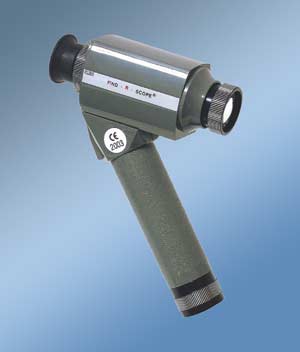Tips on staying safe when using an IR viewer.
Ken Barat, Laser Safety Officer, Lawrence Berkeley National Laboratory
If one played a word-association game with the term “laser safety,” the most common responses probably would be eyewear, goggles and, perhaps, eye injury. But as with so much in life, there is more to laser safety than immediately meets the eye. An important but often overlooked component of almost any laser-safety program is the infrared viewer.
Commonly called an IR viewer, this laboratory device makes a range of invisible wavelengths visible to the user. The typical wavelength range of most commercial IR viewers is 700 to 1500 nm, with some going out to 2000 nm. With the aid of an IR viewer, lab personnel can locate beams and find stray reflections.
Inside the viewer, optics focus the IR radiation onto an image tube, where the photons generate electrons, which in turn impinge on a phosphor screen and create a visible image. The bright spots on the visible image correspond to the most intense IR radiation in the original scene, but too bright an image can overwhelm details and detract from getting an accurate sense of the IR beam or reflection.
IR viewers come in two styles: the well-known and reliable handheld viewer and the less common hands-free model that attaches to the user’s headgear. There are clearly times when having both hands free is an advantage, and the hands-free models come in binocular and monocular versions. Regardless of the type of IR viewer, it is important to keep in mind that normal vision is compromised when peering into the viewer. On occasion, users’ heads have interacted unpleasantly with components on their optical tables. Ouch!
A common question is: If laser protective eyewear is required, can it be taken off to use the viewer? If you are wearing eyewear to protect against IR radiation only, there is no reason to remove it. You can easily see the image in the viewer. But if you are wearing eyewear to protect against visible and IR wavelengths, you may have difficulty using the viewer. In this case, you may need to remove the eyewear momentarily. “Momentarily” is the key word. You are very vulnerable while the eyewear is off, so exercise extreme caution and replace your eyewear the instant that you are done with the viewer.
As a word of caution to novices, “IR viewers should never be placed directly in a laser beam.”
They are intended for viewing reflections. This may seem obvious, but I have encountered a number of viewers that have been damaged by taking a direct hit. It is probably unwise for the user to put his eye that close to the beam, and placing a viewer directly in a laser beam greatly diminishes its usefulness for future work.

IR viewers help laboratory personnel locate beams and find stray reflections. One thing to remember when using IR viewers is not to place them directly in the beam path.
Your choice of an IR viewer will depend on your particular situation as well as on subjective criteria such as personal experience and preferences. FJW Optical Systems Inc. and Electrophysics Corp. have been the industry sources for these devices for years, and there also are newer firms.
An alternative approach to locating IR beams is the ubiquitous IR card, whose phosphor absorbs in the infrared and emits in the visible. Somewhat less sensitive than an IR viewer, an IR card will fluoresce when placed directly in an infrared beam, but it is not good at finding weak reflected beams. And the shiny plastic coating on many IR cards carries its own danger. Held at the wrong angle, it can reflect the IR beam directly into the viewer’s eye. IR card users should always keep this hazard in mind.
The bottom line is that an IR viewer and IR cards should be in the laser safety toolbox of users of lasers that emit between 700 and 1500 nm.
Meet the author
Ken Barat is a laser safety officer at Lawrence Berkeley National Laboratory in California and has held the same position with the National Ignition Facility Directorate at Lawrence Livermore National Laboratory; e-mail: [email protected].